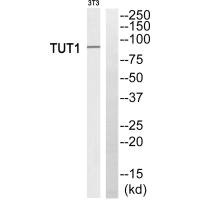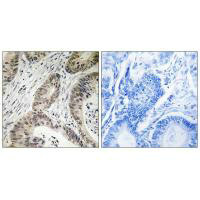TUT1 Antibody
-
货号:CSB-PA046708
-
规格:¥2024
-
图片:
-
其他:
产品详情
-
产品名称:Rabbit anti-Homo sapiens (Human) TUT1 Polyclonal antibody
-
Uniprot No.:Q9H6E5
-
基因名:TUT1
-
宿主:Rabbit
-
反应种属:Human
-
免疫原:Synthesized peptide derived from internal of Human TUT1.
-
免疫原种属:Homo sapiens (Human)
-
克隆类型:Polyclonal
-
纯化方式:The antibody was affinity-purified from rabbit antiserum by affinity-chromatography using epitope-specific immunogen.
-
浓度:It differs from different batches. Please contact us to confirm it.
-
产品提供形式:Liquid
-
应用范围:ELISA,WB,IHC
-
推荐稀释比:
Application Recommended Dilution WB 1:500-1:3000 IHC 1:50-1:100 -
Protocols:
-
储存条件:Upon receipt, store at -20°C or -80°C. Avoid repeated freeze.
-
货期:Basically, we can dispatch the products out in 1-3 working days after receiving your orders. Delivery time maybe differs from different purchasing way or location, please kindly consult your local distributors for specific delivery time.
相关产品
靶点详情
-
功能:Poly(A) polymerase that creates the 3'-poly(A) tail of specific pre-mRNAs. Localizes to nuclear speckles together with PIP5K1A and mediates polyadenylation of a select set of mRNAs, such as HMOX1. In addition to polyadenylation, it is also required for the 3'-end cleavage of pre-mRNAs: binds to the 3'UTR of targeted pre-mRNAs and promotes the recruitment and assembly of the CPSF complex on the 3'UTR of pre-mRNAs. In addition to adenylyltransferase activity, also has uridylyltransferase activity. However, the ATP ratio is higher than UTP in cells, suggesting that it functions primarily as a poly(A) polymerase. Acts as a specific terminal uridylyltransferase for U6 snRNA in vitro: responsible for a controlled elongation reaction that results in the restoration of the four 3'-terminal UMP-residues found in newly transcribed U6 snRNA. Not involved in replication-dependent histone mRNA degradation.
-
基因功能参考文献:
- Crystallographic and biochemical studies of TUT1 revealed the molecular mechanism underlying the specific oligo-uridylylation of the 3'-end of U6 snRNA by TUT1. PMID: 28589955
- Star-PAP possesses tumor-suppressing activity. PMID: 28151486
- Star-PAP-specific polyadenylation sites usage regulates the expression of the eukaryotic translation initiation factor EIF4A1, the tumor suppressor gene PTEN and the long non-coding RNA NEAT1. PMID: 28911096
- Star-PAP recognises a unique nucleotide motif on its target mRNA.CstF-64 and 3'-UTR cis-element determine Star-PAP specificity for target mRNA selection by excluding poly A polymerase. PMID: 26496945
- Nucleotidyl transferase TUT1 inhibits lipogenesis in osteosarcoma cells through regulation of microRNA-24 and microRNA-29a. PMID: 25142229
- Star-PAP controls E6 mRNA polyadenylation and expression and modulates wild-type p53 levels. PMID: 23416977
- The human TUT1 nucleotidyl transferase is a global regulator of microRNA abundance. PMID: 23874977
- Star-PAP and its regulatory molecules form a signaling nexus at the 3'-end of target mRNAs to control the expression of select group of genes including the ones involved in stress responses. (Review) PMID: 23306079
- PIPKIalpha, PI4,5P(2), and PKCdelta regulate Star-PAP control of BIK expression and induction of apoptosis. PMID: 22244330
- The data support a model where Star-PAP binds to the pre-mRNA, recruits the CPSF complex to the 3'-end of pre-mRNA and then defines cleavage by CPSF 73 and subsequent polyadenylation of its target mRNAs. PMID: 21102410
- PIPKIalpha co-localizes at nuclear speckles and interacts with a newly identified non-canonical poly(A) polymerase, Star-PAP; the activity of Star-PAP can be specifically regulated by PtdIns4,5P2 PMID: 18288197
- These data indicate that CKIalpha, PIPKIalpha, and Star-PAP function together to modulate the production of specific Star-PAP messages. PMID: 18305108
显示更多
收起更多
-
亚细胞定位:Nucleus, nucleolus. Nucleus speckle.
-
蛋白家族:DNA polymerase type-B-like family
-
组织特异性:Widely expressed.
-
数据库链接:
HGNC: 26184
OMIM: 610641
KEGG: hsa:64852
STRING: 9606.ENSP00000308000
UniGene: Hs.728983
Most popular with customers
-
-
YWHAB Recombinant Monoclonal Antibody
Applications: ELISA, WB, IF, FC
Species Reactivity: Human, Mouse, Rat
-
Phospho-YAP1 (S127) Recombinant Monoclonal Antibody
Applications: ELISA, WB, IHC
Species Reactivity: Human
-
-
-
-
-






















